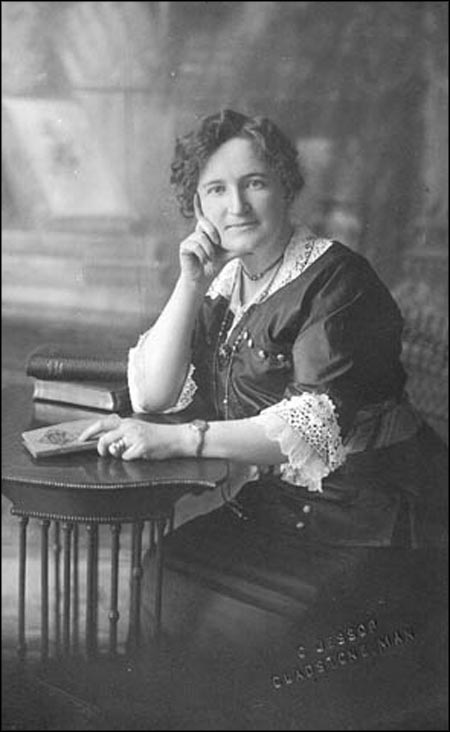Gendering History: An Unfinished Transformation
12 May 2014 - 3:10pm
 It is widely recognized that until the 1960s and 1970s the teaching of Canadian history in secondary schools focused upon the lives of “significant” individuals (mostly white men) and the development of the nation-state. As the study of Canadian history at the post-secondary level broadened to include the lives of women, working people, and others neglected by the traditional grand-narrative, K-12 education began to slowly change as well. In terms of gender history we can see evidence of this in curriculum documents and textbooks, which began to make references to significant women, such as Laura Secord or Nellie McClung in the 1970s and 1980s. While these changes were positive the addition of a few women, all of whom conformed to traditional criteria for significance (i.e., they had an impact on the development of the nation-state), it did little to change the historical narrative being taught in schools.
It is widely recognized that until the 1960s and 1970s the teaching of Canadian history in secondary schools focused upon the lives of “significant” individuals (mostly white men) and the development of the nation-state. As the study of Canadian history at the post-secondary level broadened to include the lives of women, working people, and others neglected by the traditional grand-narrative, K-12 education began to slowly change as well. In terms of gender history we can see evidence of this in curriculum documents and textbooks, which began to make references to significant women, such as Laura Secord or Nellie McClung in the 1970s and 1980s. While these changes were positive the addition of a few women, all of whom conformed to traditional criteria for significance (i.e., they had an impact on the development of the nation-state), it did little to change the historical narrative being taught in schools.
Thankfully continued pressure from many groups has led to the development of curricula and resources that attempt to integrate gender history more fully in the story of Canada. A quick glance at contemporary curricula and textbooks (published 2000 or later) will find far more references to women, as well as some discussions of gender, daily life, and struggles for equality. While these changes are heartening, a critical examination of curricula and resources can uncover some potentially problematic tendencies, which taken together indicate that the gendering of school history is still very much a work in progress.
Looking, for example, at the textbooks used in my home province (Ontario) I notice that contemporary texts are now filled with stories of women like Nellie McClung and Florence Bird. While this change is worthy of applause, it must be noted that this focus upon great women has not altered the tendency of Canadian history textbooks to focus upon the public sphere and ignore the private. It is also interesting that the faults of these great women, much like those of the great men who came before them, are ignored. For instance, Nellie McClung’s support for the sterilization of “simple minded girls” (Marsh, 2009, para. 5) is rarely mentioned by textbooks. These texts also tend to avoid controversial or disturbing gender issues. For example, Cruxton and Wilson (2000) fail to mention the Canadian eugenics movement, the fight for abortion, or the Ecole Polytechnique massacre.
Most troubling however, is the use of a narrative technique I refer to as “recognition and dismissal.” The use of this technique is quite widespread and it occurs when an author acknowledges an important historical problem, but then makes a comment or argument that implies this issue has been dealt with. For example, during their discussion of labour in the 1980s and 1990s, Cruxton and Wilson (2000) mention the problem of the “glass ceiling.” However, this is quickly followed by an explanation of how the courts and human rights tribunals have been used to ensure greater pay equity. This juxtaposition of an unjust situation with what appears to be a solution gives the impression that this issue has been adequately addressed and ignores the fact that a gendered division of labour continues to exist in Canada (Fenwick, 2004).
The frequent use of the “recognition and dismissal” technique, the one-dimensional depiction of complex historical individuals, and the continued focus upon actions within the public sphere leaves students with the impression that gender history is largely a story of perpetual progress brought about by significant individuals. This image is not only at odds with much of the academic scholarship on gender, but it also fails to raise many questions about gender of which students should be aware (e.g., how historical concepts of gender were developed and enforced; how the private sphere has often been devalued).
Of course textbooks and curriculum guides do not necessarily reflect what actually occurs in the classroom. There is also no shortage of other resources that a teacher might use to engage in a more nuanced discussion of gender history. However, until official documents and texts allocate more space and provide a more thorough investigation of gender history it is likely that many students will be presented with a narrative that is much improved (when compared to earlier periods) but still incomplete. Hopefully discussions such as those occurring this month in this blog will continue to raise awareness and provide ideas and resources for the teaching of gender history.
What are your strategies for gender-inclusive history lessons?
Photo: Nellie McClung, 1905-1922, Gladstone, Manitoba. Held at Library and Archives Canada, PA 30212, copyright expired. http://www.canadiana.org/citm/imagepopups/pa030212%20_e.html
References:
Cruxton, J.B., & Wilson, W.D. (2000). Spotlight Canada (4th edition). Toronto, ON: Oxford University Press.
Fenwick, T. (2004). What happens to the girls? Gender, work and learning in Canada’s ‘new economy.’ Gender and Education: 16(2), 169-185.
Marsh, J.H. (2009). Eugenics: keeping Canada sane. Retrieved April 1st, 2009 from:
http://www.thecanadianencyclopedia.com/index.cfm?PgNm=ArchivedFeatures&Params=A2126.
- Se connecter ou créer un compte pour soumettre des commentaires

